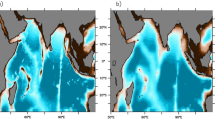Abstract
Effects of the presence of a circumpolar region on buoyancy-driven circulation are investigated by using an idealized numerical ocean model. Comparison of circulation and meridional density (heat) transport is made between a closed ocean and an ocean with a cyclic gap near its southern boundary. The presence of the circumpolar region leads to disconnection of the meridional overturning across the circumpolar region. And the circumpolar eastward flow reaches the bottom of the ocean. It is essential for this that the pycnocline is deeper than the bottom of the gap. Since the amount of the mass transported northward must return southward at the levels deeper than the bottom of the cyclic gap, the weak stratification, hence weak vertical geostrophic shear, at the deeper levels leads to inactive communication across the circumpolar region. Meridional heat transport across the circumpolar region is made mainly by horizontal diffusion for the ocean with the cyclic gap, while the contribution of the advection is dominant for the closed ocean. Sensitivity of meridional heat transport to change in horizontal diffusivity is studied. The meridional heat transport for the ocean with the cyclic gap is more sensitive than for the closed ocean. The change in heat transport occurs not only in the circumpolar region but also in the rest of the ocean. It is suggested that subgrid scale phenomena, especially mesoscale eddies, in the circumpolar region controls the whole ocean to a great extent.
Similar content being viewed by others
References
Bryan, K. (1969): A numerical method for the study of the circulation of the world ocean.J. Comput. Phys.,4, 347–376.
Bryan, K. (1984): Accelerating the convergence to equilibrium of ocean-climate models.J. Phys. Oceanogr.,14, 666–673.
Bryden, H. L. (1979): Poleward heat flux and conversion of available potential energy in Drake Passage.J. Mar. Res.,37, 1–22.
Cox, M. D. (1989): An idealized model of the world ocean. Part I: The global-scale water masses.J. Phys. Oceanogr.,19, 1730–1752.
de Szoeke, R. A., and M. D. Levine (1981): The advective flux of heat by mean geostrophic motions in the Southern Ocean.Deep-Sea Res.,28A, 1057–1085.
Gill, A. E. and K. Bryan (1971): Effects of geometry on the circulation of a three-dimensional southern-hemisphere ocean model.Deep-Sea Res.,18, 685–721.
Kuo, H. H. and G. Veronis (1973): The use of oxygen as a test for an abyssal circulation model.Deep-Sea Res.,20, 871–888.
Masuda, A. and K. Uehara (1992): A reduced-gravity model of the abyssal circulation with Newtonian cooling and horizontal diffusion.Deep-Sea Res.,39, 1453–1479.
Roemmich, D. (1980): Estimation of meridional heat flux in the North Atlantic by inverse methods.J. Phys. Oceanogr.,10, 1972–1983.
Rossby, H. T. (1965): On thermal convection driven by non-uniform heating from below: an experimental study.Deep-Sea Res.,12, 9–16.
Stommel, H. (1962): On the smallness of sinking region in the ocean.Proc. Nat. Acad. Sci. U.S.A.,48, 766–772.
Suginohara, N. and S. Aoki (1991): Buoyancy-driven circulation as horizontal convection on β-plane.J. Mar. Res.,49, 295–320.
Suginohara, N. and M. Fukasawa (1988): Set-up of deep circulation in multi-level numerical models.J. Oceanogr. Soc. Japan,44, 315–336.
Suginohara, N., S. Aoki and M. Fukasawa (1991): Comments on “On the importance of vertical resolution in certain oceanic general circulation models”.J. Phys. Oceanogr.,21, 1699–1701.
Author information
Authors and Affiliations
Rights and permissions
About this article
Cite this article
Ishikawa, I., Yamanaka, Y. & Suginohara, N. Effects of presence of a circumpolar region on buoyancy-driven circulation. J Oceanogr 50, 247–263 (1994). https://doi.org/10.1007/BF02239516
Received:
Revised:
Accepted:
Issue Date:
DOI: https://doi.org/10.1007/BF02239516




